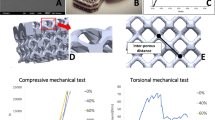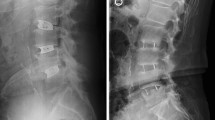Abstract
Purpose
To determine the impact of mechanical stability on the progress of bone ongrowth on the frame surfaces of a titanium-coated polyether ether ketone (TCP) cage and a three-dimensional porous titanium alloy (PTA) cage following posterior lumbar interbody fusion (PLIF) until 1 year postoperatively.
Methods
A total of 59 patients who underwent one- or two-level PLIF for degenerative lumbar disorders since March 2015 were enrolled. Bone ongrowth of all cage frame surfaces (four surfaces per cage: TCP, 288 surfaces and PTA, 284 surfaces) was graded by 6-month and 1-year postoperative computed tomography color mapping (grade 0, 0‒25% of bone ongrowth; grade 1, 26‒50%; grade 2, 51‒75%; and grade 3, 76‒100%).
Results
Bone ongrowth (≥ grade 1) was observed on 58.0% and 69.0% of the surfaces of TCP and PTA cages 6 months postoperatively and on 63.5% and 75.0% of those 1 year postoperatively, respectively. In the TCP cages, bone ongrowth grade increased from 6 months to 1 year postoperatively only in the union segments (median, 1 [interquartile range, IQR, 0–2] to 1 [IQR, 0–3], p = 0.006). By contrast, in the PTA cages, it increased at 6 months postoperatively in the union (1 [IQR, 1–2] to 2 [IQR, 1–3], p = 0.003) and non-union (0.5 [IQR, 0–2] to 1 [IQR, 0–2.75], p = 0.002) segments.
Conclusion
Early postoperative mechanical stability has a positive impact on the progress of bone ongrowth on both the TCP and PTA cage frame surfaces after PLIF.






Similar content being viewed by others
Availability of data and materials
The datasets generated during the current study are available from the corresponding author on reasonable request.
References
McGilvray KC, Easley J, Seim HB, Regan D, Berven SH, Hsu WK, Mroz TE, Puttlitz CM (2018) Bony ingrowth potential of 3D-printed porous titanium alloy: a direct comparison of interbody cage materials in an in vivo ovine lumbar fusion model. Spine J 18:1250–1260. https://doi.org/10.1016/j.spinee.2018.02.018
McGilvray KC, Waldorff EI, Easley J, Seim HB, Zhang N, Linovitz RJ, Ryaby JT, Puttlitz CM (2017) Evaluation of a polyetheretherketone (PEEK) titanium composite interbody spacer in an ovine lumbar interbody fusion model: biomechanical, microcomputed tomographic, and histologic analyses. Spine J 17:1907–1916. https://doi.org/10.1016/j.spinee.2017.06.034
Walsh WR, Bertollo N, Christou C, Schaffner D, Mobbs RJ (2015) Plasma-sprayed titanium coating to polyetheretherketone improves the bone-implant interface. Spine J 15:1041–1049. https://doi.org/10.1016/j.spinee.2014.12.018
Walsh WR, Pelletier MH, Christou C, He J, Vizesi F, Boden SD (2018) The in vivo response to a novel Ti coating compared with polyether ether ketone: evaluation of the periphery and inner surfaces of an implant. Spine J 18:1231–1240. https://doi.org/10.1016/j.spinee.2018.02.017
Shinbo J, Mainil-Varlet P, Watanabe A, Pippig S, Koener J, Anderson SE (2010) Evaluation of early tissue reactions after lumbar intertransverse process fusion using CT in a rabbit. Skeletal Radiol 39:369–373. https://doi.org/10.1007/s00256-009-0733-7
Makino T, Kaito T, Sakai Y, Takenaka S, Yoshikawa H (2018) Computed tomography color mapping for evaluation of bone ongrowth on the surface of a titanium-coated polyetheretherketone cage in vivo: a pilot study. Medicine 97:e12379. https://doi.org/10.1097/MD.0000000000012379
Schreiber JJ, Anderson PA, Rosas HG, Buchholz AL, Au AG (2011) Hounsfield units for assessing bone mineral density and strength: a tool for osteoporosis management. J Bone Joint Surg Am 93:1057–1063. https://doi.org/10.2106/jbjs.j.00160
Landis JR, Koch GG (1977) The measurement of observer agreement for categorical data. Biometrics 33:159–174
Phan K, Hogan JA, Assem Y, Mobbs RJ (2016) PEEK-Halo effect in interbody fusion. J Clin Neurosci 24:138–140. https://doi.org/10.1016/j.jocn.2015.07.017
Dimitriou R, Babis GC (2007) Biomaterial osseointegration enhancement with biophysical stimulation. J Musculoskelet Neuronal Interact 7:253–265
Marco F, Milena F, Gianluca G, Vittoria O (2005) Peri-implant osteogenesis in health and osteoporosis. Micron 36:630–644. https://doi.org/10.1016/j.micron.2005.07.008 (Oxford, England: 1993)
Olivares-Navarrete R, Gittens RA, Schneider JM, Hyzy SL, Haithcock DA, Ullrich PF, Schwartz Z, Boyan BD (2012) Osteoblasts exhibit a more differentiated phenotype and increased bone morphogenetic protein production on titanium alloy substrates than on poly-ether-ether-ketone. Spine J 12:265–272. https://doi.org/10.1016/j.spinee.2012.02.002
Yoon BJ, Xavier F, Walker BR, Grinberg S, Cammisa FP, Abjornson C (2016) Optimizing surface characteristics for cell adhesion and proliferation on titanium plasma spray coatings on polyetheretherketone. Spine J 16:1238–1243. https://doi.org/10.1016/j.spinee.2016.05.017
Rao PJ, Pelletier MH, Walsh WR, Mobbs RJ (2014) Spine interbody implants: material selection and modification, functionalization and bioactivation of surfaces to improve osseointegration. Orthop Surg 6:81–89. https://doi.org/10.1111/os.12098
Tang D, Yang LY, Ou KL, Oreffo ROC (2017) Repositioning titanium: an in vitro evaluation of laser-generated microporous, microrough titanium templates as a potential bridging interface for enhanced osseointegration and durability of implants. Front Bioeng Biotechnol 5:77. https://doi.org/10.3389/fbioe.2017.00077
Kienle A, Graf N, Wilke HJ (2016) Does impaction of titanium-coated interbody fusion cages into the disc space cause wear debris or delamination? Spine J 16:235–242. https://doi.org/10.1016/j.spinee.2015.09.038
Torstrick FB, Klosterhoff BS, Westerlund LE, Foley KT, Gochuico J, Lee CSD, Gall K, Safranski DL (2018) Impaction durability of porous polyether-ether-ketone (PEEK) and titanium-coated PEEK interbody fusion devices. Spine J 18:857–865. https://doi.org/10.1016/j.spinee.2018.01.003
Eger M, Hiram-Bab S, Liron T, Sterer N, Carmi Y, Kohavi D, Gabet Y (2018) Mechanism and prevention of titanium particle-induced inflammation and osteolysis. Front Immunol 9:2963. https://doi.org/10.3389/fimmu.2018.02963
Moon SG, Hong SH, Choi JY, Jun WS, Kang HG, Kim HS, Kang HS (2008) Metal artifact reduction by the alteration of technical factors in multidetector computed tomography: a 3-dimensional quantitative assessment. J Comput Assist Tomogr 32:630–633. https://doi.org/10.1097/RCT.0b013e3181568b27
Wellenberg RHH, Hakvoort ET, Slump CH, Boomsma MF, Maas M, Streekstra GJ (2018) Metal artifact reduction techniques in musculoskeletal CT-imaging. Eur J Radiol 107:60–69. https://doi.org/10.1016/j.ejrad.2018.08.010
Lengsfeld M, Gunther D, Pressel T, Leppek R, Schmitt J, Griss P (2002) Validation data for periprosthetic bone remodelling theories. J Biomech 35:1553–1564. https://doi.org/10.1016/s0021-9290(02)00187-2
Lee IS, Kim HJ, Choi BK, Jeong YJ, Lee TH, Moon TY, Won Kang D (2007) A pragmatic protocol for reduction in the metal artifact and radiation dose in multislice computed tomography of the spine: cadaveric evaluation after cervical pedicle screw placement. J Comput Assist Tomogr 31:635–641. https://doi.org/10.1097/01.rct.0000250117.18080.d8
Ito K, Horiuchi T, Arai Y, Kawahara I, Hongo K (2014) Histological, mechanical, and radiological study of osteoformation in titanium foam implants. Acta Neurochir, 156: 2165–2172. Discussion 2172. https://doi.org/10.1007/s00701-014-2122-9
Acknowledgement
The authors want to thank Dr. Yuya Kanie (Department of Orthopaedic Surgery, Osaka University Graduate School of Medicine, Suita, Japan) for his valuable help in the statistical part of this study.
Funding
None.
Author information
Authors and Affiliations
Corresponding author
Ethics declarations
Conflicts of interest
The authors declare that they have no conflicts of interest.
Ethics approval
All procedures performed were in accordance with the HELSINKI declaration 1964. This research has been approved by the IRB of the authors’ affiliated institutions.
Informed consent
The research protocol was approved and publicized by the authors’ affiliated institution, and the patients were given the right to opt out of the study.
Additional information
Publisher's Note
Springer Nature remains neutral with regard to jurisdictional claims in published maps and institutional affiliations.
Rights and permissions
About this article
Cite this article
Makino, T., Takaneka, S., Sakai, Y. et al. Impact of mechanical stability on the progress of bone ongrowth on the frame surfaces of a titanium-coated PEEK cage and a 3D porous titanium alloy cage: in vivo analysis using CT color mapping. Eur Spine J 30, 1303–1313 (2021). https://doi.org/10.1007/s00586-020-06673-4
Received:
Revised:
Accepted:
Published:
Issue Date:
DOI: https://doi.org/10.1007/s00586-020-06673-4




